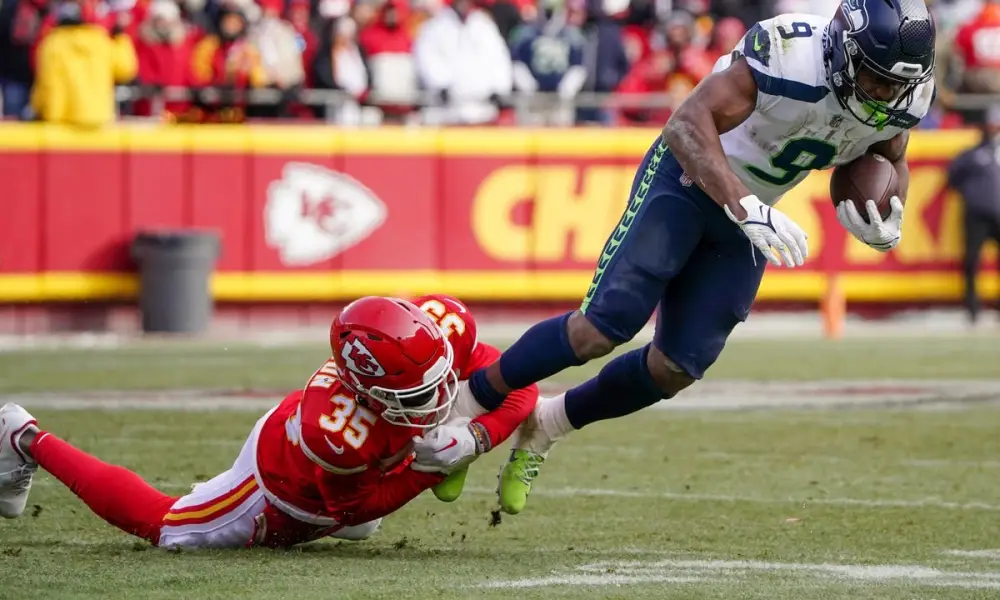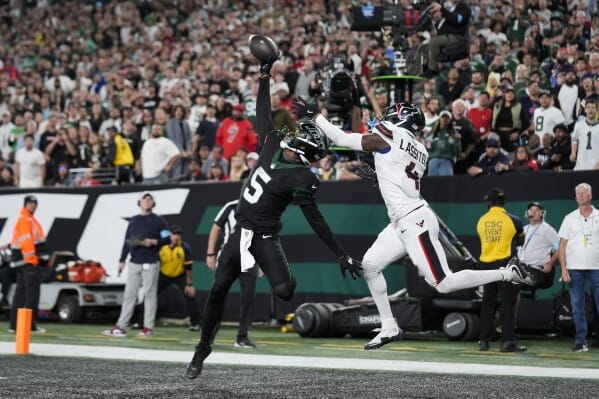
RB Success Rate Scrubs
NFL Next Gen's success rate metric can help identify running backs with upside for big-time goal-line workloads. It can also help us avoid RBs whose teams are less likely to trust them in high-leverage situations.
NFL Next Gen's Rushing Metrics
As I covered in Part 1 of this series, this analysis uses NFL Next Gen's ROE% metric (which I will refer to as success rate). This metric is based on player tracking data and measures how often an RB is running for more yards than expected. Because it's based on the player tracking data, it can account for nuances like defender positioning. Unlike NFL Next Gen's rush yards over expected (RYOE) metric, success rate is not a great indicator of RB explosiveness. Instead, it helps measure consistency.
One would expect consistency to be prized in goal-line situations. And success rate has had a weak but intriguing correlation with carries inside the 10-yard line (green zone) in the following season.
The chart below shows success rate and following season green-zone carries per game for RBs with 200+ carries in both seasons.

Obviously, simply hitting on RBs with 200+ carry workloads would be a huge edge on its own. But ADP is generally good at accounting for projected RB workloads. Success rate can potentially help us avoid RBs who may underperform even if they receive the workloads their ADP suggests.
As I covered in RB Success Rate Stars, the point of this analysis isn't necessarily to determine which RBs are actually good goal-line backs. As Jamaal Williams showed last year, you can struggle in success rate and still rack up TDs. Instead, the goal is to get a better sense of which RBs are most likely to have their coaches' trust at the goal line.
2022 Success Rate Red Flags
Last season, nine RBs logged at least 200 attempts while delivering less than a 40% success rate.
The worst two performers on the list are currently free agents. Given that Dalvin Cook and Ezekiel Elliott were very recently the faces of their franchises, their releases this offseason reinforce the idea that success rate is picking up on something that NFL coaches care about.

Dalvin Cook
The Vikings' telegraphed release of Cook and his quiet free-agent market since are both very concerning. It appears the NFL no longer views him as a difference-making RB.
Cook posted 40%, 45%, and 40% success rates from 2019-2021 before cratering to 34% last year. He also showed less explosiveness, with -56 rush yards over expected. On a per-attempt basis, he finished just behind David Montgomery and Antonio Gibson and just ahead of Rachaad White and Najee Harris. He may not have much left in the tank.
Cook's receiving ability also appears to be declining. From 2017-2020, he averaged 1.50 YPRR. Over the last two years, he's down to 0.77 and is coming off a career-low 0.72 YPRR.
ESPN's receiver ratings are an even bigger red flag. Over the last two seasons, Cook ranks RB44; only Ezekiel Elliott has been worse.
With cratering rushing and receiving efficiency, Cook represents a late-round dart throw-level bet. His late 7th-round ADP is bewildering. In nearly 200 completed Underdog drafts, I have yet to select him. That leaves me open to a dream landing spot ADP spike. But Cook's best path to crushing me is by racking up TDs in a good offense. His success rate indicates that he's vulnerable to goal-line competition even if he lands with a high-powered offense. And fundamentally, at this point in his career, I don't view Cook as a significantly better talent-based bet than the other free-agent RBs.
Ezekiel Elliott
Ezekiel Elliott is in the midst of a multi-year decline. He peaked in 2018 with 161 rush yards over expected, producing very efficiently per attempt. He then fell slightly to 139 RYOE in 2019, despite handling 43 additional carries. But the first real red flag showed up in 2020 when he produced just 15 RYOE on 244 carries.
But even in 2020, Elliott was a consistent runner. He posted a 43% success rate, a drop from 2019's 45% but an improvement on 2018's 42%. He wasn't as explosive but was still able to reliably deliver positive runs.
But in 2021, the wheels fell off. His success rate cratered to 36%, and he took another step back in explosiveness with -43 RYOE. Things only got worse last year; he posted a 35% success rate with an NFL-low -98 RYOE. Among RBs with 100+ carries, only Michael Carter was worse on a per-attempt basis last year.
Elliott's receiving ability has also declined to almost unbelievable lows. In his 2018 prime, he posted 1.32 YPRR. But he's fallen in every year since—dropping to a terrible 0.64 YPRR in 2021 before posting an abysmal 0.39 last year.
In ESPN's receiver ratings, Zeke ranks RB45 – dead last – over the previous two years.
Elliott was a star. But entering his age-28 season, he appears to have almost nothing left in the tank.
But... best ball is partly a game of getting players at good prices. And without the ability to pounce on waiver-wire breakouts, it sometimes makes sense to prioritize boring veterans who should have some sort of NFL role. In other words, although I'm almost ashamed to admit it, I'm comfortable drafting Zeke—but only because he's essentially free. Despite major questions surrounding his current talent level, he has enough volume upside to justify some fliers in the last rounds of drafts.
Still, I have 5% exposure on Underdog. I'm willing to take him, but I'm underweight. At his price, he can pay off by simply falling into the end zone a few times in the right week. But with two seasons of horrendous success rates, that's an unlikely outcome.
His best bet is to re-sign with Dallas, where institutional memory could keep him involved at the goal line. A new team will not like what they see on his recent tape.
Kenneth Walker
Kenneth Walker's 35% success rate qualifies as highly concerning—especially because rushing is supposed to be where Walker excels.
Walker entered the league with major receiving red flags. He ran just 9.3 career routes per game in college, less than half of Breece Hall's 21.0. And when he did run routes, he was ignored. Walker's 0.45 college YPRR is the lowest among all Day 1-2 RBs since 2015.
Walker's college receiving inefficiency transferred to his rookie season; he posted a 0.63 YPRR in 2022. Among all RBs with 25+ targets, only Jonathan Taylor (0.56), Ezekiel Elliott (0.39), and Miles Sanders (0.28) were worse.
Identifying receiving volume has been the easiest way to hit on legendary RB seasons in the modern NFL:
"15 of 16 legendary seasons since 2010 have come with 4+ receptions per game. Any time we draft an early-round running back who is unlikely to hit 4+ receptions per game, we’re swimming against the current in a big way.
On the other hand, finding running backs with big receiving roles has been highly profitable. Since 2000, there have been 96 running back seasons with 4+ receptions per game with 12+ games played. 25% of those seasons have produced 23+ points per game. Since 2010, that percentage jumps to 31%."
But Walker is coming off a rookie season where he averaged just 1.75 receptions per game, well below the 4+ reception per game mark that has regularly accompanied elite fantasy seasons. It's fair to say that Walker's receiving profile limits his path to a high-ceiling season. And that was true before the Seahawks drafted Zach Charbonnet in the second round.
However, Walker's two-down profile isn't news; it was his biggest red flag entering the league. Fortunately, Walker's NFL rushing production also matched his explosive college rushing profile. Walker posted 30.1 breakaway yards per game in 2022; only Nick Chubb (31) finished higher.
As a premier breakaway threat, Walker will remain heavily involved as a rusher this season. His big-play ability is too impressive for the Seahawks to ignore.
But... you don't need your goal-line rusher to be overly explosive. Instead, it's vital that he hits the right hole and gets the yards in front of him. Walker's awful 35% success rate creates risk that Charbonnet will eat into his goal-line work. That risk will increase as the season progresses and Charbonnet gets more comfortable in the offense.
I've been picky about drafting Walker while aggressively targeting Charbonnet. Going 50+ picks after Walker, the rookie has the potential to lead the backfield in high-value touches if Walker doesn't improve his rushing consistency. Charbonnet is my third-most-drafted RB.
But I'm not out on Walker. His 5th-round ADP somewhat bakes in his downside risk. Even as a committee back, he can pay off at cost if his long runs land in the big-money best ball weeks. After hard fading Walker in early drafts, I'm up to 6% since his ADP slide.
Jamaal Williams
Williams is coming off a 17-TD campaign, but the Saints may be far less interested in feeding him at the goal line than the Lions were last season. Williams was a more consistent rusher than D'Andre Swift... but Swift set a very low bar. Including the playoffs, only Darrell Henderson (32%), James Robinson (33%), and Michael Carter (34%) finished lower in success rate than D'Andre Swift last year.


